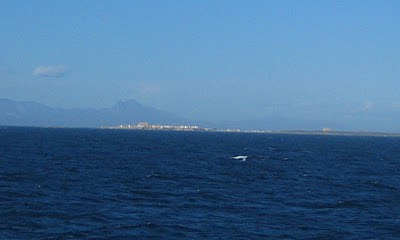Although not located in the Alboran Sea, deserve to be so by its history, which is why we devote a few lines to this island located off Cape Santa Pola in Alicante province.

(VIEW FROM THE SOUTHEAST TABARCA)
Tabarca, formerly known as Illa Plana and Illa de Sant Pau, remained deserted until the orders of Charles III built a small fortress defended by a series of fortifications reminiscent of the Third and Fourth Precinct Melilla.
To populate the island was settled many families of Genoese origin from other Mediterranean island which inherited the name: Tabarka, situated on the northern coast of Tunisia, which currently is attached, near the border with Algeria.

(TABARCA VIEW FROM THE SOUTH)
Tabarka was famous for the quantity and quality of red coral, which led to fishermen and Italian and Catalan merchants to visit the island since the late twelfth century . Of these fisheries in the Tunisian coasts coral Leo Africanus includes the following story in his Description of Africa, "Bona Not far from a beach where there is much coral. But no one enjoys the right to fish in the sea or pick it up at the beach because the king who rented the Genoese harassed by pirates, asked permission to build a fortress. But people did not consent, they argued, on another occasion the Genoese, with this scheme is apoderadon of the city and looted. "

(VIEW OF THE POPULATION OF TABARCA)
Tabarka enclave became a Genoese Lomellini family owned mid-sixteenth century to join, as some authors, rescue the pirate Barbarossa had to pay for the Genoese Dragut released, his top deputy and successor at the helm of the Barbary pirates and Ottoman fleet. Tabarka
Genoese hands became a rich enclave where coral traded wheat, captives and information on the movement of each other in the Mediterranean.
finally the Bey of Tunis succeeded in conquering the city in 1741, capturing all its inhabitants who went into captivity to Tunisia and then to Algiers.
In Algiers spent long years in captivity until in 1768 he negotiated a Exchange of prisoners between the corsair city and Spain who were beneficiaries of the ancient inhabitants of Tabarka in Algiers and were not sufficient to offset the English captives Algerian prisoners in Spain, hence they are admitted to the exchange. The Genoese arrived in Cartagena with the English captive released and settled there until, as we mentioned earlier, Carlos III ordered his transfer to the New Tabarca. "
0 comments:
Post a Comment